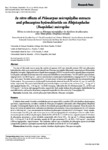Please use this identifier to cite or link to this item:
http://www.alice.cnptia.embrapa.br/alice/handle/doc/1048461| Title: | In vitro effects of Pilocarpus microphyllus extracts and pilocarpine hydrochloride on Rhipicephalus (Boophilus) microplus. |
| Authors: | CASTRO, K. N. de C.  LIMA, D. F.   WOLSCHICK, D.   ANDRADE, I. M. de   SANTOS, R. C. dos   SANTOS, F. J. de S.   VERAS, L. M. C.   COSTA-JÚNIOR, L. M.   |
| Affiliation: | KARINA NEOOB DE CARVALHO CASTRO, CPAMN; DAVID FERNANDES LIMA, Anidro do Brasil Extrações S. A., Parnaíba, PI, Brasil; DOLORES WOLSCHICK, CPAMN; IVANILZA MOREIRA DE ANDRADE, UFPI; RAIMUNDA CARDOSO DOS SANTOS, UFPI; FRANCISCO JOSE DE SEIXAS SANTOS, CPAMN; LEIZ MARIA COSTA VERAS, UFPI; LÍVIO MARTINS COSTA-JÚNIOR, UFMA. |
| Date Issued: | 2016 |
| Citation: | Brazilian Journal of Veterinary Parasitology, Jaboticabal, v. 25, n. 2, p. 248-253, abr./jun. 2016. |
| Description: | The aim of this study was to assess the activity of aqueous (AE) and ethanolic extracts (EE) and pilocarpine hydrochloride, which were extracted and isolated from Pilocarpus microphyllus (Jaborandi), respectively, on Rhipicephalus (Boophilus) microplus. High performance liquid chromatography (HPLC) was performed to quantify these compounds. Larval packet and adult immersion tests were conducted with different concentrations. Five AE and EE concentrations, ranging from 6.2 to 100.0 mg mL?1, and six concentrations of pilocarpine hydrochloride, ranging from 0.7 to 24.0 mg mL?1, were tested. The lethal concentration (LC50) of each extract for larvae and engorged females was calculated through Probit analysis. The concentration of pilocarpine hydrochloride obtained from the EE and the AE was 1.3 and 0.3% (m/m), respectively. Pilocarpine hydrochloride presented the highest acaricidal activity on larvae (LC50 2.6 mg mL?1) and engorged females (LC50 11.8 mg mL?1) of R.(B.) microplus, followed by the EE which presented LC50 of 56.4 and 15.9 mg mL?1, for larvae and engorged females, respectively. Such results indicate that pilocarpine hydrochloride has acaricidal activity, and may be the primary compound responsible for this activity by P. microphyllus EE. |
| Thesagro: | Acaricida Carrapato Parasito |
| Keywords: | Controle fitoterápico Acaricide Parasite Phytotherapy control Tick |
| ISSN: | 0103-846X |
| DOI: | http://dx.doi.org/10.1590/S1984-29612016032 |
| Type of Material: | Artigo de periódico |
| Access: | openAccess |
| Appears in Collections: | Artigo em periódico indexado (CPAMN)  |
Files in This Item:
| File | Description | Size | Format | |
|---|---|---|---|---|
| ArtigoKarinaNeoob.pdf | 668,7 kB | Adobe PDF |  View/Open |









